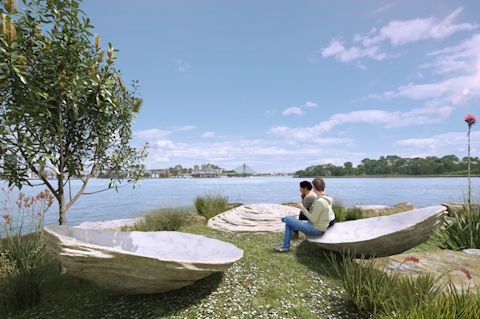Yuwaalaraay designer Lucy Simpson's oyster installations with accompanying soundscapes are planned for prime locations along the harbour as part of a 9km foreshore walk highlighting historically significant Aboriginal sites, people and stories.
Guided by its Aboriginal and Torres Strait Islander Advisory Panel, the City of Sydney will continue a series of conversations with local Aboriginal communities to gather and embed local narratives of place to share alongside the sculptures.
The oyster artworks are the latest component of a walk from Pirrama (Pyrmont) to Wallamool (Woolloomooloo) curated by Emily McDaniel called Yananurala, a name from the Sydney Aboriginal language meaning to walk Country. Eleven interpretive signs have already been installed along the route.

The installations depict clusters of mud flat oyster forms, once prevalent in the harbour, and will sit at water's edge locations like Yurong (Mrs Macquarie's Point), the Woolloomooloo bay foreshore, Cockle Bay and the headland at Barangaroo.
These locations highlight relationships with other key sites across waterways and in the distance. Audio will enhance the experience of being on Country, bringing to life the rich narratives of the harbour, and cultural and social heritage of the sites.
Simpson's design for the Sitelines and Conversations sculptures was selected following an open callout for ideas for this phase of the long-term Yananurala project.
"These installations are a celebration of Country, story and relationships. They provide an invitation to connect to continuing ways of knowing and relating to Country," designer Lucy Simpson said.
"People can sit, stand, touch and connect with these works, hold conversations with each other and with time, and tune in to Country and reflect on the deep layers of history and stories at these sites.
"What I loved about these oyster shell forms is a layering of time embodied in their shapes; you can read their experience and memory. Their growth rings are worn and aged as they've moved with the tides and rested in the sun. They also come from this first point of contact at Kamay (Botany Bay), a significant meeting point where histories collide, intertwine and sit atop one another. This place and these forms are complex and layered."
The Metropolitan Local Aboriginal Land Council has been involved in the project from its inception.
"Lucy Simpson's oyster installations along the water's edge will provide an opportunity for everyone to be immersed in the local culture when travelling into Country. You pay respect by becoming one with that Country," Metropolitan Local Aboriginal Land Council CEO, Nathan Moran, said.
These works are part of the City of Sydney's long-standing Eora Journey: recognition in the public domain program, which includes a series of major public artworks by Aboriginal and Torres Strait Islander artists.
"These beautiful and functional artworks will encourage people to take a moment and connect with their surroundings and with the histories, stories and living culture of Aboriginal and Torres Strait Islander peoples," Lord Mayor of Sydney, Clover Moore AO said.
"Through their placement and arrangement, along with accompanying audio, the works tell stories of people and places and of community connection, resilience and stewardship.
"Sydney's history, particularly in relation to Aboriginal and Torres Strait Islander communities, includes events and attitudes that our current policies and initiatives need to redress. The impact of colonisation is particularly poignant along this coastline as the first site of invasion, so using it as platform to celebrate Aboriginal heritage and culture is powerful.
"It has long been the City's policy to redress the imbalance of Aboriginal and Torres Strait Islander recognition and perspectives in public spaces by investing in artworks by Indigenous artists. By acknowledging our shared past, we are laying the groundwork for a future which embraces all Australians, a future based on mutual respect and shared responsibility for this land."
Final project details will be confirmed following further consultation with local Aboriginal and Torres Strait Islander communities.
Development applications for the installations will be submitted later this year. The sculptures are expected to be installed in 2026.
The City of Sydney is collaborating with Placemaking NSW, Infrastructure NSW, Royal Botanic Garden Sydney and Sydney Opera House on the project.
More about artist Lucy Simpson
Grounded in and guided by the timeless and sophisticated philosophies of Indigenous design, Lucy Simpson's Wangal/Sydney based multi-disciplinary practice connects to narratives of Country through function, materiality and transfer, through a wide range of applications spanning commercial, conceptual and community-based projects and collaborations across a wide range of media.
A graduate of UNSW Art and Design and current PhD candidate at the University of Technology Sydney, Simpson's creative practice and research focus is on the continuing role of Indigenous design as tool and conduit to baayangalibiyaay/interconnected notions of wellbeing (people and place).






